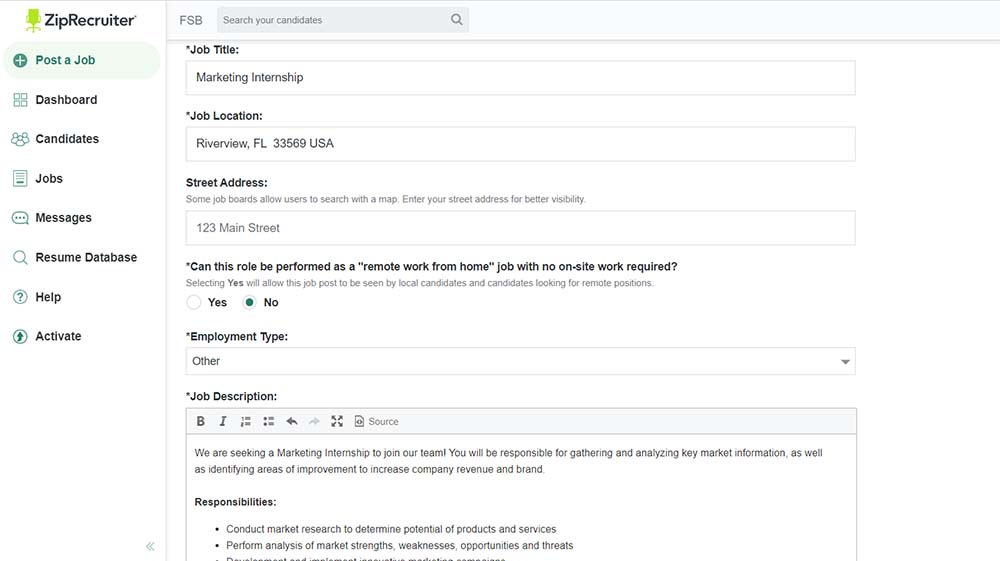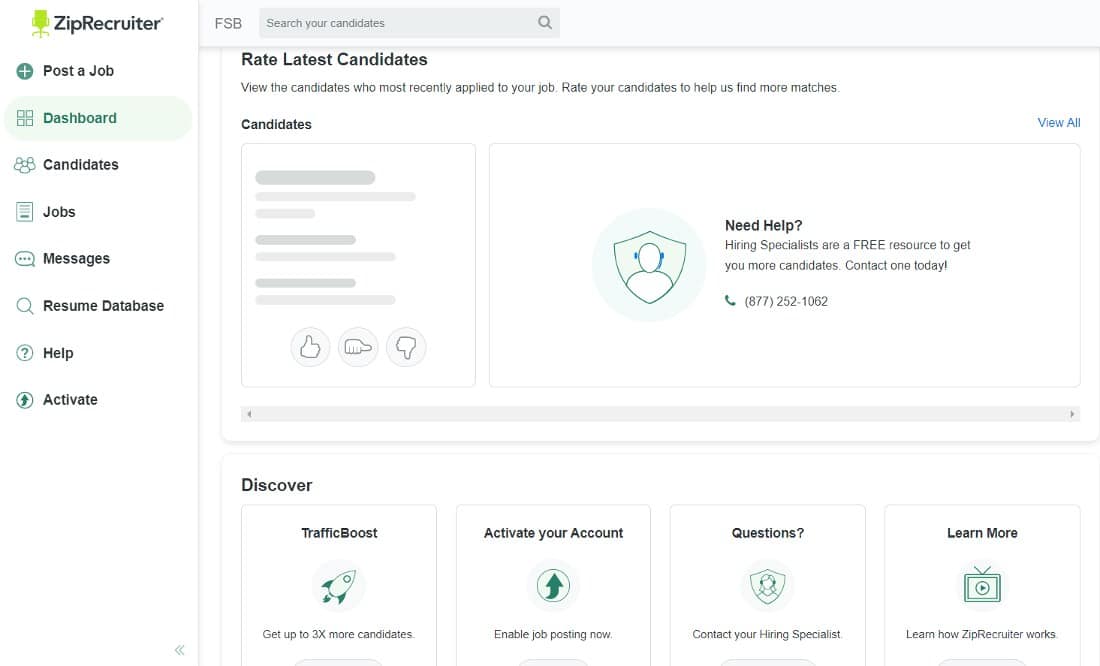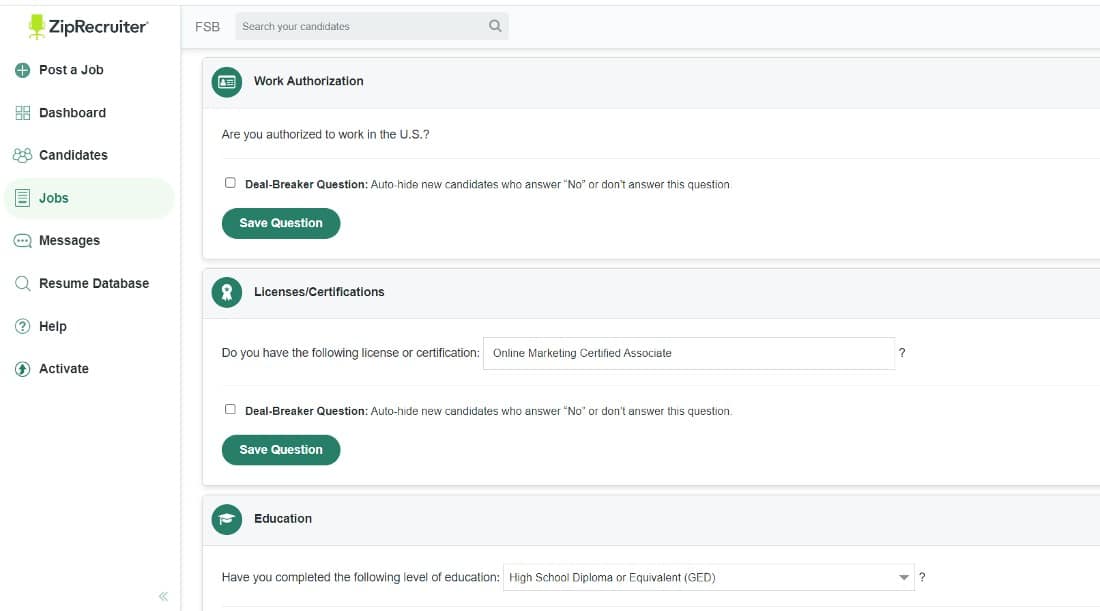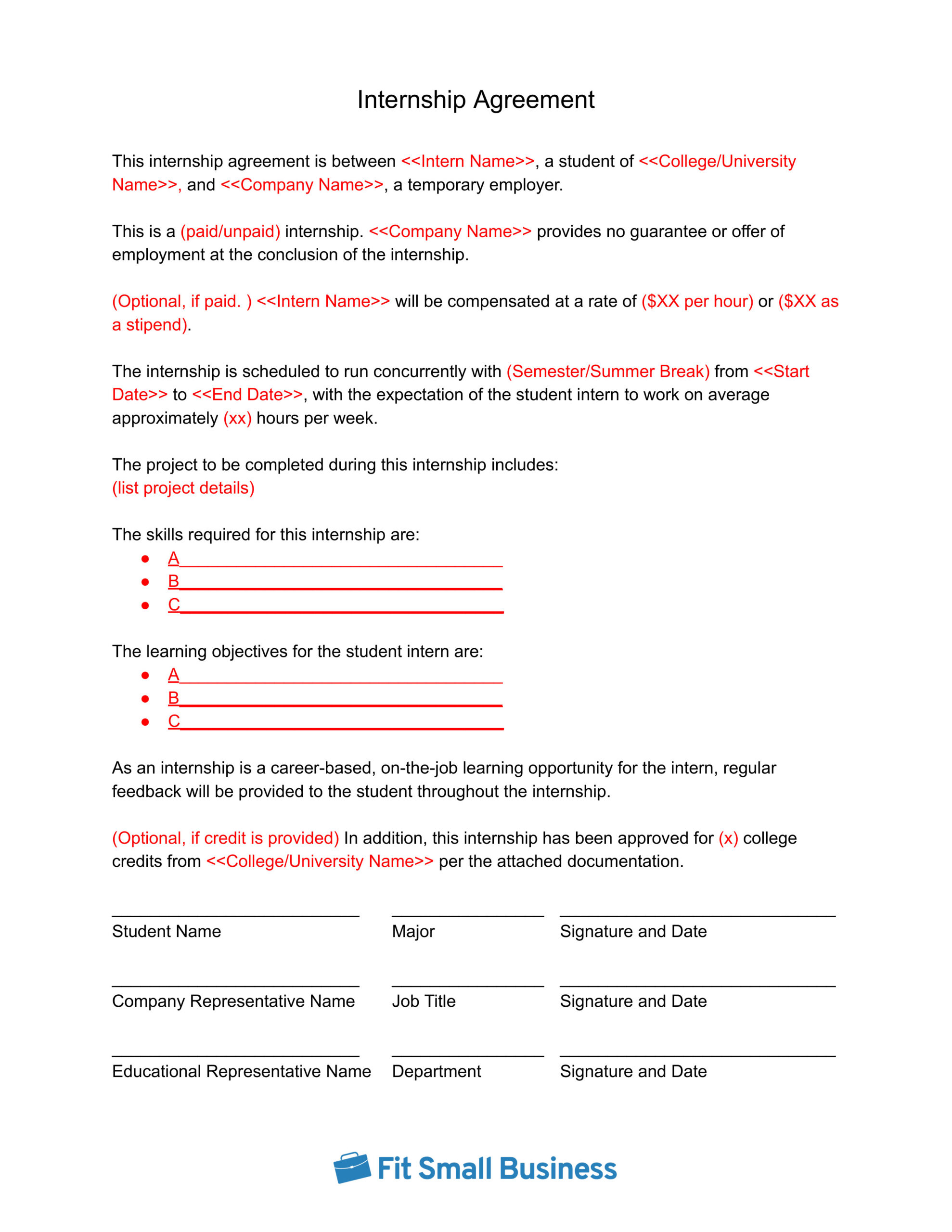Hiring an intern is a great way to tap into talented individuals who haven’t yet or have just graduated from college. The first step in this process is determining your needs and what your internship program will look like. You can then find interns by contacting your college career center or searching on job boards like ZipRecruiter. After you’ve interviewed candidates and made your hire, you’ll need to add them to your payroll system or otherwise arrange their pay.
Continue reading for more information on how to hire an intern successfully. Also, download and customize our internship agreement template to ensure that both the intern and your company agree on the particulars of the program.
Step 1: Determine Your Needs
Your company’s specific needs will determine how your internship program will proceed. Decide upfront what you want an intern to do, and establish how learning or developing that expertise will help them build career skills to focus your intern search.
An internship can be as follows:
- Position-based or project-based;
- Paid or unpaid; and
- Flexible or full-time.
Interns can be valuable assets for ongoing roles that require fresh perspectives, creative ideas, and up-to-date knowledge of the latest industry trends and technologies. For example, if your business is undergoing a digital transformation or looking to revamp its social media strategy, an intern can bring innovative ideas and contemporary skills to the table. Positions that involve continuous research and development, such as market analysis or product development, can benefit from the inquisitive nature of interns, who are eager to learn and contribute.
Whereas a traditional job position may focus on a myriad of job duties, an internship is typically focused on a much smaller skills-based project (similar to contract work). It’s not uncommon for interns to do project-based research-related tasks resulting in a deliverable—such as a report, which is often in conjunction with a class or field of study.
Below are examples of projects that interns can provide based on their academic major:
- Statistical Research: Students studying international business, economics, or biomedical topics can often assist with data analytics and trend analysis.
- Engineering Deliverables: Students studying engineering or architecture may be able to help you set up and launch your 3D printer or redesign your warehouse or retail store layout.
- Graphic Design: Art and design students often need to build out their portfolios while in school. They can upgrade your existing website and marketing collateral with images. Marketing students learning to work with website development tools may be able to help you jumpstart or optimize your retail ecommerce site, for instance.
- Streamline Business Processes: A business student could be tasked with documenting your processes to expose potential time savers or software tools. An HR or instructional design student could be tasked with creating a new hire onboarding program for new hire orientation and training.
Unpaid internships are for nonprofits and firms that comply with Fair Labor Standards Act (FLSA) internship guidelines, which we will discuss in more detail below. Paid internships require you to comply with federal law to pay at or above the minimum wage for your state (the current federal rate is $7.25 an hour). However, some states like Michigan and Minnesota allow employers to pay a lower “training wage” that applies to students and interns; the specifics vary by state. Learn more about minimum wage exemptions in our guide.
Compliance Note: Misclassifying interns can result in legal repercussions, including back pay, fines, and damage to reputation. To mitigate these risks, companies shoulddo the following:
- Document Learning Objectives: Clearly outline the educational aspects of the internship, how it benefits the intern, and ensure these objectives are met throughout the program.
- Review Intern Contributions: Regularly assess the intern’s tasks to ensure they do not veer into employee territory without appropriate compensation.
- Consult Legal Advice: When in doubt, seeking advice from a lawyer or HR expert who specializes in labor and employment laws can provide clarity and safeguard against potential legal challenges.
Interns are typically part-time workers with flexible schedules. Some schools offer co-op programs that alternate school and work to allow students to obtain real-life experience while they’re taking classes. In general, you’ll need to consider the work hours you’re looking for and the amount of supervision and training you’re able to provide during those internship hours.
These are some common examples of internship schedules:
- Part-time School-year Internship: Interns are often available for work schedules ranging from five to 20 hours a week during the school year.
- Part-time Summer Internship: Some interns prefer to take on assignments during the summer, such as 20 hours a week during June and July.
- Full-time Semester Internship: There may be times when your intern wants to take a break from their study schedule and embed themselves full-time in their chosen field.
In general, unpaid internships need to align closely with the academic calendar, whereas paid internships provide you with more scheduling flexibility. There are also other options, like bringing a foreign graduate student over for a year-long internship. In those cases, you’ll be responsible for providing a living wage to the intern while also managing housing, transportation, and other costs, such as healthcare.
Step 2: Find Interns
Once you’ve decided on the type of job and type of intern you need, you should begin looking for an intern. A great place to start is with academic institutions that train students in those skill sets. If you’re looking for a biomed research intern, for example, you’d likely search universities with medical programs. You may also want to consider looking through social media and using job boards.
- Universities: Many universities have structured internship programs that provide students with college credit for their internship experience. Others manage paid internship programs for students, and a few offer funds to support their learners participating in unpaid internships.
- Colleges: Your local community college may have an internship program too. But even if they don’t, it’s a great place to find a student intern. You can contact the career center or visit the school and chat with a faculty member who teaches the kind of courses you’d like your intern to have taken, such as Accounting 101 or Electrical Engineering. Further, most local colleges have a place you can post your internship opportunity—even if it’s just a note card pinned to an old-fashioned bulletin board in a cafeteria, computer lab, or student center.
- Trade Schools: Local trade schools in your area may have similar programs to help match you with an intern in fields ranging from animal husbandry to welding. These schools may also have a place to post your internship opportunity.
In addition to contacting relevant academic institutions and engaging directly with potential interns on social media, you can also find students and recent college graduates searching for internships on job boards. In fact, there are niche job boards that target student job placements, and many universities have their own job boards managed through the career center.
- Employment Job Sites: Free job boards and paid job posting sites allow you to post your internship opportunities and track interns who apply by using their applicant tracking tools. This helps you avoid discrimination issues by being able to monitor your intern outreach.
- Internship Job Board: Internships.com is an example of a job board that specifically targets employers looking for interns and students looking for career experiences. Both paid and unpaid internship seekers can be found on this website; however, you have to sign up to post jobs and view student resumes. Other intern job boards include InternJobs.com, CollegeRecruiter.com, and LinkedIn.com.

ZipRecruiter offers job description templates that you can customize to fit your internship requirements.
Step 3: Review Resumes & Interview
Be sure that the intern has the skills necessary to perform the job at hand by screening their resume. While they may not have a lot of work experience, they can include educational experiences on their resumes to showcase their skills.

ZipRecruiter allows you to view resumes and rate candidates based on their skills and education.
It is also necessary to interview them before hiring them. You can conduct interviews with interns in the same manner that you would interview a potential employee: by phone, by video, or in person. In these interviews, you should focus on the intern’s career path and skills needed to succeed in the future. Your available position may help them learn and master the skills needed to pursue a career in that field.

Before a traditional interview, ZipRecruiter will allow you to require candidates to enter screening questions during the application process.
It’s not uncommon for interns to be recommended by a faculty adviser or for there to be only one or two interns available for the exact skills you seek. In that case, you may opt not to go through a full interview process.
Step 4: Hire & Train Your Intern
After selecting your intern, finalize the hiring process with a clear agreement, similar to that of a full-time employee. This agreement, often coordinated with the intern’s school, should outline specific projects or outcomes, such as a deliverable report or data analysis, clearly stating the payment terms, if applicable. It’s crucial to document the internship’s duration, typically aligned with the academic calendar, and clarify that employment post-internship isn’t guaranteed. Ensure all parties sign the agreement.
Then, you need to train your intern, similar to the onboarding process for any other employee. Make sure you’ve established learning objectives that align with the intern’s academic goals and your business needs. Designate a mentor or point of contact within your team who can guide the intern, answer questions, and provide feedback.
Start with an orientation to introduce them to your company’s culture, processes, and the specific tools they’ll use. Regular check-ins throughout their internship will help adjust the learning path as needed to ensure the intern feels supported and gains educational content from their experience.
Pro Tip: Even for internships, you should have a structured onboarding program. This should outline the internship’s objectives, give insight into your company culture, and assign a mentor for guidance. Read our onboarding best practices guide for more information.
Also, providing an excellent internship program goes beyond just getting them started. You will have to make it a fruitful learning experience for them. Regular check-ins and constructive feedback support the intern’s growth and enhance their experience. Check out our recommended types of employee training for some options.
Step 5: Pay Your Intern
If it’s your first time hiring an intern, you may not be sure how best to pay them. If you already have paid employees, you can simply add the intern as a temporary employee to your payroll system. We recommend easy-to-use software like Gusto, as it tracks workers’ earnings, manages payroll taxes, and provides W-2 tax forms. Gusto is our top recommended payroll software for small businesses—learn more about it in our Gusto review.
Another option, if you’re paying a lump sum stipend, is to process the payment in your accounting software. For example, with QuickBooks—our best overall accounting software—you can provide a stipend payment similar to that of an independent contractor and send the intern a 1099-Misc at year-end. Read more about the platform in our QuickBooks Online review.
Academic Credit
In some cases, students can earn college credit for the work they do with your firm in lieu of pay. The school will require you to give the intern valuable work experiences that further their educational experience—and some even require you to complete a final report or evaluation on the student’s work.
Calculators for Computing Intern’s Pay
Pros & Cons of Hiring Interns
The benefits of hiring an intern include getting some project work done and helping you identify talent to bring into your company once they graduate from college. Best of all, it improves your employment brand, as you “give back” to your community by training future workers and leaders.
| PROS | CONS |
|---|---|
| Improves Your Employment Brand: You can give back to the community by investing in local talent and shoring up your existing workforce with eager, fresh faces. | Takes Time: Managing interns requires onboarding and training. While it makes sense to do this for full-time employees, it might not make sense for a two-month internship. |
| Creates a Talent Pipeline: You may find potential future employees who may want to work for you or can recommend smart talent within their social network to apply for jobs. | May Create Resentment: By design, interns must be provided with flexible schedules so that they can attend classes. Your current workers may not appreciate what appears to them as special treatment for the intern. |
| Brings in Fresh Perspectives: Interns can bring the benefits of new technology, new approaches, and research-based insights. | Must Comply with FLSA: Those wishing to structure unpaid internships must be sure not to violate the FLSA, or they risk having to provide back pay and labor law fines. |
Hiring an Intern for Full-time Employment
If your internship program has employee placement in mind, you need to make sure you are hiring the right intern for the position. Also, the process is different from hiring an employee, so you need to use a different set of criteria.
Here is what you might want to consider:
- Performance and Skills: Assess the intern’s performance throughout their internship. Look for indicators of their ability to meet deadlines, produce quality work, and contribute to projects. Consider their technical skills, relevant experience, and willingness to learn and improve. Look for interns who have shown growth and demonstrated the potential to excel in a full-time role.
- Cultural Fit: Evaluate how well the intern fits within the company’s culture and values. Consider their attitude, work ethic, and interpersonal skills. Assess their ability to collaborate with team members, adapt to the company’s environment, and align with its mission and vision. Look for interns who have integrated well and have a positive impact on the work environment.
- Professionalism and Reliability: Consider the intern’s level of professionalism, including their punctuality, communication skills, and ability to handle responsibilities. Assess their reliability, accountability, and ability to work independently and as part of a team. Look for interns who demonstrate maturity and take their work seriously.
- Growth Potential: Evaluate the intern’s potential for growth within the company. Consider their ability and willingness to develop new skills, take on additional responsibilities, and adapt to evolving roles. Look for interns who display a desire to advance their careers and have the capacity to contribute to the organization’s long-term goals.
- Long-term Interest: Assess the intern’s interest in joining the company as a full-time employee. Have open conversations with them about their career aspirations and their commitment to the organization. Look for interns who express a genuine interest in continuing their journey with the company and have a clear understanding of its industry and future prospects.
- Feedback and Recommendations: Consider the feedback provided by the intern’s supervisors, mentors, and colleagues. Their observations and recommendations can offer valuable insights into the intern’s performance, potential, and fit within the company. Seek input from those who have directly worked with the intern to gain a well-rounded perspective.
- Team Dynamics: Assess how well the intern has integrated into the team and the impact they have made on their colleagues. Consider their ability to collaborate, communicate effectively, and build relationships within the company. Look for interns who have established positive working relationships and have contributed to a cohesive team environment.
When considering the transition of an intern into a full-time employee, assigning real projects can significantly contribute to seamless integration. Real projects provide an opportunity for interns to showcase their skills, demonstrate their ability to handle tasks similar to those of permanent employees, and foster a sense of ownership and investment in the outcomes, further solidifying their commitment to the company.
Frequently Asked Questions (FAQs)
Start by setting clear expectations about the internship’s duration, objectives, and learning opportunities. Provide a comprehensive orientation that introduces your company culture, essential team members, and daily operations. Assign a mentor for ongoing support and ensure all necessary resources and tools are readily available.
Use multiple channels for recruitment. Craft engaging job descriptions highlighting the value and learning opportunities of the internship. Consider attending career fairs and hosting informational sessions to attract top talent.
Yes, but you must coordinate with educational institutions to ensure the internship meets academic requirements and provides substantial learning benefits. It’s important to establish these agreements before the internship begins and clearly communicate the terms to your intern.
Bottom Line
The best way to hire an intern is to determine in advance how much time you’re willing to spend providing rich learning experiences and what kind of skills a student might bring to your organization in the short time they’re available. After that, it’s all about finding the best fit and documenting an internship agreement.
Get your internship job post on more than 100 job sites and social networks with ZipRecruiter. Try the platform for free and choose the combination of recruiting tools that most closely fit your needs.

Social recruiting is gaining popularity in recruitment, as it offers a wide pool of potential hires—including interns. Select platforms like LinkedIn for professional postings, and don’t ignore X, Instagram, and TikTok for a broader reach.
Create engaging and informative content that uses visuals and concise language to grab attention. Use relevant hashtags to enhance visibility. Engaging with educational institutions on these platforms can extend your reach to students looking for opportunities. Check out our guide to creating a “We’re Hiring” social media post to make posts that engage.
Be proactive in monitoring your posts—answer inquiries promptly to show your commitment to engaging new talents. Consistency in your social media activity will ensure you attract qualified candidates effectively.